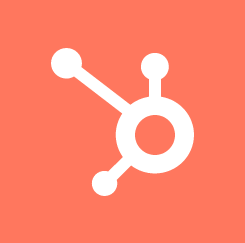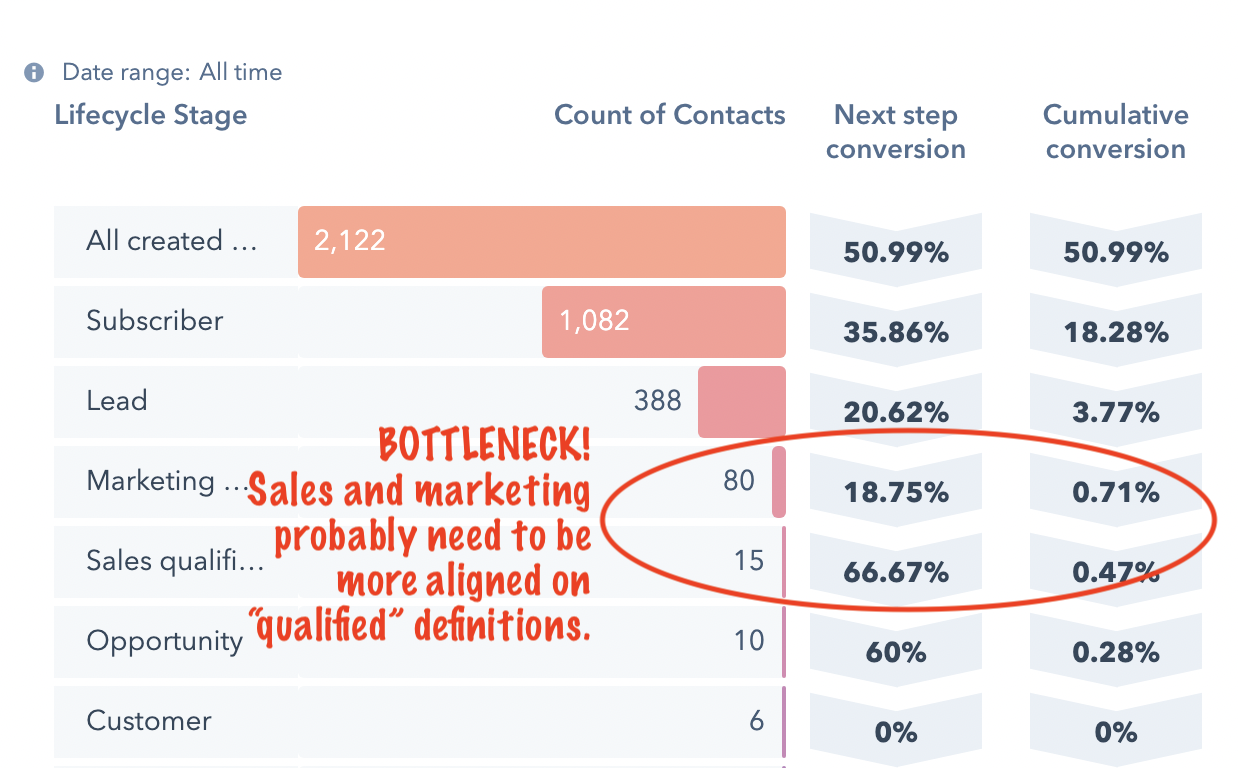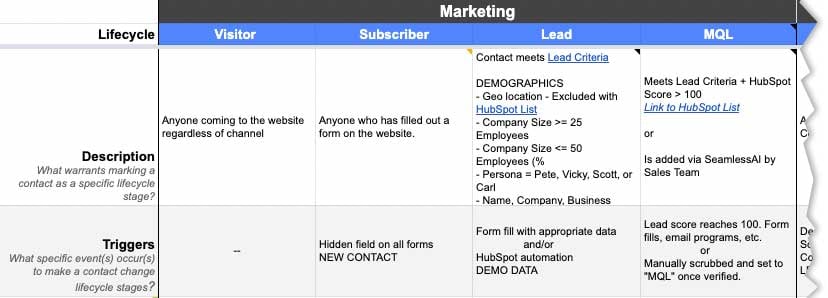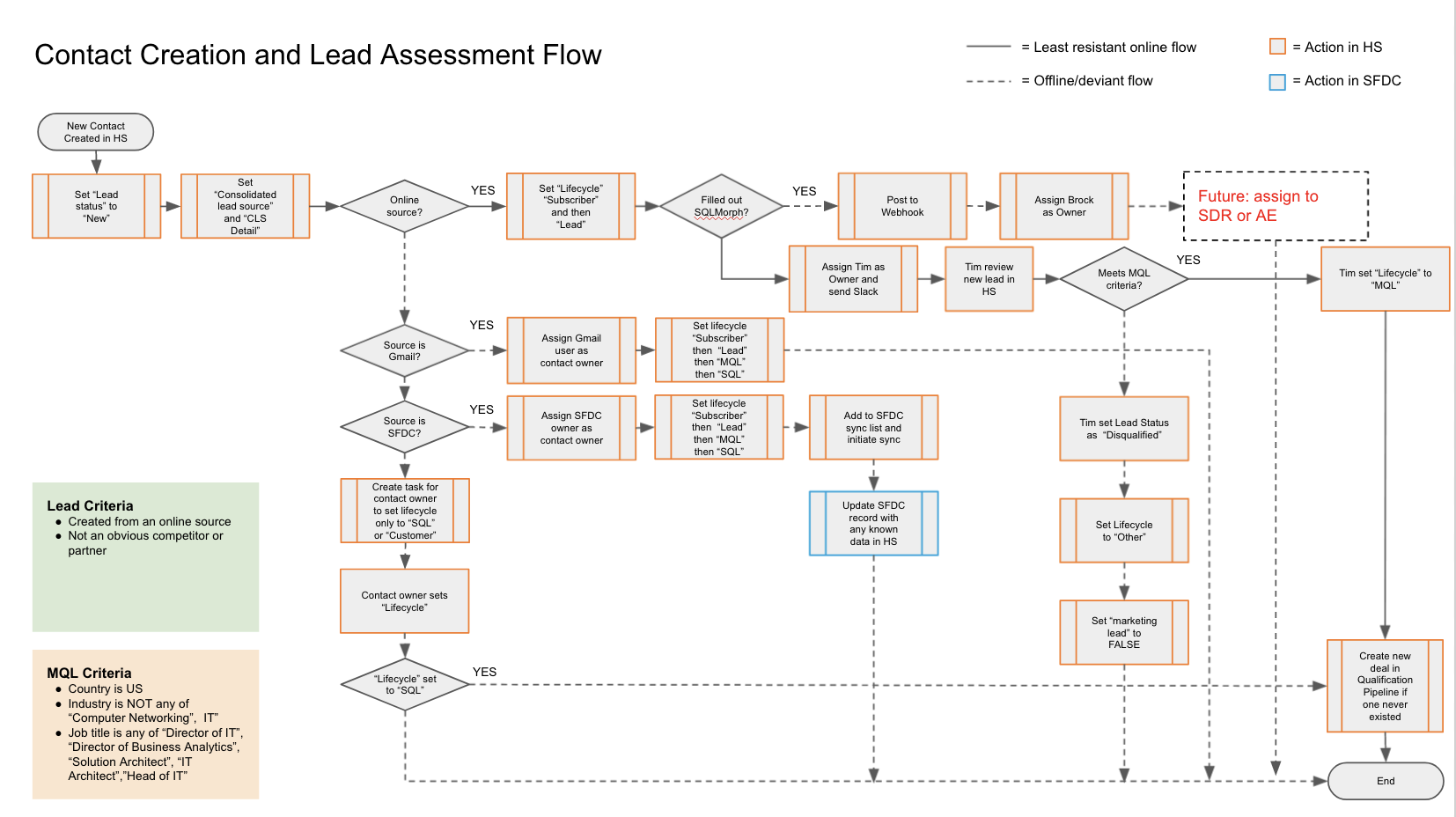How to get started with RevOps on HubSpot (a practical guide for SMBs)
by Joseph Freeman | Updated Jan 26, 2024
So, you've spent some time learning about how RevOps can blast revenue bottlenecks in your business (if not, we'll briefly touch on it below). You've already got HubSpot — or you have heard about how amazing it is as an all-in-one CRM, Marketing, Sales, and Support tool. And now, the big question is...
..."how do I get started with RevOps on HubSpot?"
Well, here at Digitopia we take our customers through a 6-phased journey to getting up and running with RevOps on HubSpot. I'll outline that in detail below (and even provide links to the planning tools we use), but first...let's start at the very beginning ("a very good place to start ♫").
Here's what we'll cover (feel free to jump to #5 if you're already caught up):
- What is RevOps?
- Why are companies shifting their focus to RevOps?
- The 6 clarifying questions to ask yourself as you prepare for RevOps
- How can HubSpot help your company implement its RevOps Strategy?
- 6-phased approach to setting up RevOps on HubSpot
- Your next steps for RevOps on HubSpot
1. What is RevOps?
Revenue Operations (RevOps) is a business function that aims to maximize an organization's revenue potential. You're probably familiar with marketing operations or sales operations: each has its own set of software, defined processes, and people for making sure each department runs smoothly...
...but, who's in charge of looking for operational bottlenecks between departments? RevOps, that's who!
By putting process, platform, and people in place dedicated to identifying bottlenecks between business functions you're unlocking a whole new layer of revenue potential. This is a huge philosophical shift for many who have been used to working in the siloes of marketing, sales, and service departments for years and years. If you want to dive deeper into all things RevOps check out our article The Ultimate Guide to Revenue Operations (RevOps).
But, if you already have a good understanding of RevOps, let's move on...
2. Why are companies shifting their focus to RevOps?
Business leaders start looking to RevOps when they're ready to scale; when their business growth is faster than their investment growth.
Early-stage companies typically aren't built to scale.
So, when they finally start to outgrow the "systems" that got them off the ground...their operations start to break down. Often small businesses are started with a good product or service and a bunch of tenacious, scrappy networking by the owner.
This get's them to their first several million dollars in revenue—but, then what?
At about $3M—$5M in revenue, homegrown processes and cobbled-together software start falling behind the actual sales need. It's hard to hire and train an effective sales team without documentation and without software governing and reporting on all activities across the entire buyer's journey.
So, if you feel like you're outgrowing the processes, platforms, and even people that got you HERE...maybe it's time for RevOps to get you THERE.
Here we go...
3. The 6 clarifying questions to ask yourself as you prepare for RevOps
- Data — "Do I have high-quality and accessible data across the revenue chain to support consistent and interdependent planning, execution, and measurement?"
- Measurement — "Does my company have an integrated and aligned view of our revenue engine (sales, marketing, service) with a shared understanding of performance metrics and KPIs?"
- Go-to-Market Strategy — "Is there a consistent agreement and understanding of my company’s GTM strategy across sales, marketing, and customer success?"
- Infrastructure — "Are the technologies supporting my revenue engine (martech, sales tech, customer success tech) integrated and sharing data?"
- Go-to-Market Planning — "Do I have a cross-functional and integrated process for planning, budgeting, resourcing, and driving revenue engine execution?"
- Lead Management — "Do I have an end-to-end process for lead management across marketing, sales, and customer success?"
Most likely the answer to one or more (maybe all) of the questions above is..."NO."
This is where HubSpot can save the day!
Ready to take your first RevOps step?
Book your FREE RevOps assessment call HERE »
4. How can HubSpot help your company implement its RevOps Strategy?

HubSpot is like an SMB's RevOps dream-come-true. It houses (almost) everything you need to manage your customer journey all under one software roof:
- CRM
- Marketing automation
- Sales tools
- Help desk and ticketing tools
- Documentation
- Templates
- And so much more
And, because all of the data across all business functions live in one system it makes reporting a breeze.
- No more cobbling together middleware
- No more integrating 3rd-party reporting
- No more manual imports/exports of data from system to system every Monday morning
HubSpot helps you answer all the questions above (data, measurement, go-to-market, etc.) with a..."YES!"
This makes HubSpot the perfect choice for a small business looking to implement RevOps! It allows you to easily identify bottlenecks in your buyer's journey without having to connect a bunch of disparate systems.
DISCLAIMER: Yes, we know some businesses (especially enterprise-level) have needs and proprietary operations systems far more complex than what HubSpot can cover in terms of RevOps. Those companies need true ERPs, custom dashboard solutions, data scientists, veteran Revenue Operations leaders, and a bit of pixie dust to effectively run RevOps. But even for those companies, we would still recommend HubSpot as the best marketing automation software on the market.
So, now that you've found a platform to help you build a solid RevOps strategy on it's time to dig in!
5. Digitopia's 6-phased approach to setting up RevOps on HubSpot?
Okay. So you've decided RevOps on HubSpot is the way to go—but, how do you get started?
Well, it's a long, ongoing journey to truly realize the full potential of RevOps in your business. But, here are the practical steps we guide business leaders through to get their HubSpot portal ready for RevOps.
We call them "phases" because some are no small task. Each of these phases can take a week—or months—to accomplish.
Don't give up. Remember, RevOps is a journey...not a destination.
What are Digitopia's 6 phases to setting up RevOps on HubSpot?
- Onboard and understand your data by better visualizing it
- Define your lifecycle stages and triggers
- Establish your method of measurement
- Map out the flow of your buyer's journey
- Create the automation to govern your lead flow
- Follow a monthly roadmap to continuously optimize your HubSpot
Want to learn more about setting up RevOps on HubSpot?
Book time with an expert to talk about RevOps on HubSpot »
Phase 1: Onboard and understand your data by better visualizing it
First, get all your basic HubSpot settings and templates in order. This can happen pretty quickly. Here's a HubSpot setup checklist if you need it.
Next, import and audit your existing (and new) marketing and sales data.
The best way to know if your data is good or bad is to start pulling it into visual reports—charts, graphs, and tables. Since you're primarily concerned with bottlenecks in the customer journey (which equals missed revenue opportunities) here are a couple of easy ones to start with:
Lifecycle Stage Conversion Funnel Report
This shows you conversion percentages at each stage and allows you to identify where prospects are getting stuck along their journey to "customer".

In this example, Marketing Qualified Leads (MQLs) aren't converting to Sales Qualified Leads (SQLs) at an acceptable rate...probably means marketing and sales need to be better aligned on their definition of "qualified".
This is something you as a RevOps leader can actually address and fix!
Lifecycle Stage Distribution Report
This shows all of the contacts in the database and which lifecycle stage they are currently sitting in. Look at the high counts in the "Subscriber" and "Lead" stages. Even though we'll always have more contacts there than in "Opportunity" and "Customer" you need to investigate why it's SO high.

Are you bringing in too many unqualified leads? If so, tighten up our lead capture, perhaps by optimizing ad spend.
This will help you stop eating into your revenue!
Or...are you not properly nurturing what ARE good leads? If so, optimize your BDR/SDR efforts and start qualifying and creating conversations.
And, pick up more revenue once-and-for-all!
Again...something you as a RevOps leader can actually address and fix!
These are just starter examples. There are many more reports that can (and should) be pulled to start understanding whether or not your data is good enough to be trusted.
If you need help sorting through your existing data, let's talk!
Book time with a RevOps on HubSpot expert HERE »
Phase 2: Define your lifecycle stages and triggers
HubSpot comes out of the box with lifecycle stages and basic definitions. But, RARELY do we find marketing, sales, and service teams all aligned around what defines each stage AND, more importantly, what moves a contact from one stage to another once they meet the appropriate criteria...
...does their lifecycle stage change manually?
...does it change through automation?
...OR, does it change through an API update from a 3rd-party CRM?
You need to define what is responsible for this lifecycle stage movement. And, then you need to set up your workflows, validation, and permissions to ensure that it happens the same way—every single time.
Here's a sample of a few stages defined using Digitopia's Technical Lifecycle Journey Mapping Tool...

This lifecycle journey map is the exact tool our team uses to get B2B organizations aligned around lifecycle stages and their triggers.
Get Digitopia's Technical Lifecycle Journey Map tool HERE »
Phase 3: Establish your method of measurement
In order to monitor and optimize for bottlenecks on an ongoing basis, you need to know what you're looking for. Take each of the lifecycle stages in HubSpot and assign the following to them:
Accountability — This is someone who will answer for the problems and help implement solutions for fixing them. Usually, the marketing, sales, or service leader takes the lead on one or more lifecycle stages.
Conversions — Document your current conversion rates from one lifecycle stage to the next. You'll likely see you have a huge drop in conversion from MQL to SQL if you've never analyzed this before.
Key Performance Indicators (KPIs) at Each Stage - Pick the one or two main metrics you want to see on a dashboard at each level. These should be big things that allow you to easily identify a bottleneck. Examples are "# of MQLs" at the Marketing Qualified Leads stage; or "$ Amount of New Opportunites" at the "Opportunity" stage.
Metrics at Each Stage - These are leading metrics at each stage. If the KPIs are the end result, after-the-fact number, what are the numbers leading up to that letting you know you might have a bottleneck on the horizon?
Here's a sample from Digitopia's Implementation Matrix tool. It shows an example of how you can lay it out...

Establishing these now will allow you to build dashboards in HubSpot to help you easily spot revenue bottlenecks in the future.
Want the full template to start documenting your B2B lifecycle stage KPIs and accountability?
Get Digitopia's RevOps Implementation Matrix HERE »
Phase 4: Map out the flow of your buyer's journey
With your lifecycle stages defined and their movement governed by documented standard operating procedures (SOPs) and the proper HubSpot setup, it's time to make sure everyone in the company knows exactly how leads (ultimately revenue potential) flow through your organization.
And the truth is, YOU probably don't even know yourself...be honest.
And since you can't fix what you don't know is broken, this is how you're going to see where data could be breaking down.
Gather up your marketing, sales, and service leaders and hash through an actual flow chart of how leads move through your organization. It's important to talk through every entry point, every decision path, and every experience that a customer may have.
You'll be amazed at how many "cracks" you'll find that prospects are falling through. These could be:
- Cracks in hand-offs between departments
- Cracks in automation where prospects are getting stuck and forgotten about
- Cracks in data syncs between software systems where prospects are never making it to your sales team
Build this flow chart as a digital slide. Just use PowerPoint or Google Slides—unless you have a fancier tool at your disposal. Now, fill in all those cracks! Get as detailed as you need to and make sure you have a path for every possible scenario along your prospect's journey.
Here's an example of the first part of a lead flow. This is just a sample. The actual chart is 6 slides long...

If you'd like to have someone facilitate this exercise with your team...
Get help with mapping your B2B buyer's journey »
Phase 5: Create the automation to govern your lead flow
This one is going to be VERY custom to your specific needs. You need to strategically wield HubSpot's plethora of tools including:
- Workflows
- Deal stage validation
- Lead scoring
- User and group permissions
I wish I could give you a playbook and a silver bullet here...but, it's no small task.
It requires an understanding of the tools in HubSpot, and in many cases, a decent understanding of how databases are constructed — and even some javascript knowledge.
PRO TIP: HubSpot's newest hub offering, Operations Hub, opens up a world of data sanitization and validation tools through the ability to add custom javascript to your workflows. Budget accordingly for this step and consider using an official HubSpot Solutions Partner and/or a javascript developer.
Basic HubSpot setup tasks like template customization, DNS setup, and user management can all be done in a relatively short amount of time. But this level of customized setup can take months to complete.
So, mentally prepare for a journey...but once on the other side of this setup, you'll see that it's well worth the investment of both time and money!
- You'll have your well-oiled marketing, sales, and service machine ensuring the very best, seamless experience for both your prospects/customers AND your internal team.
- You'll know your data is clean and reliable.
- You'll have the ability to pull meaningful reports at the drop of a hat...and, this is more than half the battle when getting properly set up for RevOps.
Phase 6: Follow a monthly roadmap to continuously optimize your HubSpot
This phase is ongoing — For...Ev...Er.
There's no such thing as "set it and forget it" with HubSpot.
Just like buying a car that you want to keep running for many years to come, your HubSpot will need constant tune-ups, oil changes, and upgrades as your business evolves. Realistically, the first 5 phases just got you off to the races with RevOps on HubSpot...they didn't give you your dream setup.
Do one "special project" a month for a year to get the most out of HubSpot
It's true...
A lot of the features in HubSpot are point-and-click and ready to use out-of-the-box. But, there are a ton of tools that are like a blank canvas waiting for a HubSpot artist to come and turn them into something beautiful.
For those heavier-lifting setups, many of which involve strategy and buy-in from your exec team, you'll want to put in place a monthly (if not weekly) Smarketing meeting. This will make sure your marketing and sales teams are aligned on both the efficacy of incoming leads AND your HubSpot optimization roadmap.
Here is a very common HubSpot optimization roadmap example we see many businesses adopt after their initial HubSpot onboarding and setup is complete. It is one "special project" per month that ensures you are systematically chipping away at all of the important, often-under-utilized, magic in HubSpot:
- Email and landing page customization
- Chatbot setup and monitoring
- Custom object creation
- Deep-dive segmentation
- Sales sequences for outbound
- Sales snippets and templates setup
- Marketing nurturing workflows
- Content funnel automation
- In-depth lead scoring
- Target account setup and training (HubSpot's answer to account-based marketing)
- Product library setup
- Net Promoter Score (NPS) survey setup
In addition to a monthly special project you should also be doing the following recurring maintenance in your hub:
- Monthly on-site technical SEO cleanup using HubSpot's SEO tool
- Monthly removal of unqualified leads
- Quarterly buyer persona review and maintenance
- Custom report creation and maintenance
6. Your next steps for RevOps on HubSpot
Well, that was a lot.
So, your very first next step is to simply decide if RevOps on HubSpot is right for your company.
If you need help navigating those waters, book some time with a Digitopia RevOps on HubSpot expert. In just 30-min you'll know whether or not RevOps on HubSpot is right for you.
And when you decide it's time to start operationalizing your revenue just roll up your sleeves and tank the plunge on your own.
Use this guide as a springboard. You can do it!
And, if you find you can't...just give us a call...we'd love to help.
Need a little guidance in getting started with RevOps on HubSpot?
Check out Digitopia's HubSpot services »








